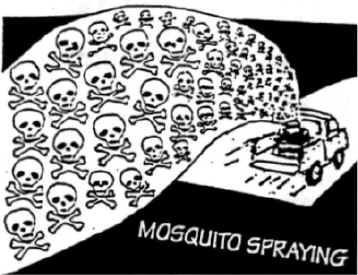 |
No Spray News James Irwin |
 |
No Spray News James Irwin |
March 11, 2002 Page 3
Is Malathion a Carcinogen?
Journal
of Pesticide Reform Use of malathion by farmers in Iowa and Minnesota has recently been linked to an increased risk of one type of cancer, non-Hodgkin's lymphoma. 32 Risks of the disease were elevated for those farmers who had ever handled. malathion and significantly elevated for farmers who used malathion prior to 1965. Risks were greater for those treating livestock than for those using malathion on crops. In another study, similar increased risks were found for Nebraska farmers using malathion. 33 A nationwide study of flour mill employees found a significant excess risk of developing non-Hodgkin's lymphoma among employees of flour mills.34 The risk rose with increased duration of work. Malathion is commonly used in flour mills for insect control. The National Cancer Institute (NCI) has studied the carcinogenicity of malathion and malaoxon in rats and mice. An independent review of this study found benign and malignant tumors of the endocrine glands, brain, liver, lung, and blood. 28 Liver neoplasms were found In mice. 28 An EPA toxicologist also found evidence of thyroid tumors in rats and liver tumors in mice. 35 Dr. Brian Dementi, another toxicologist with EPA, concurred and "found that the NCI study indicates a positive oncogenic response. 36 In re-examining its original study, NCI found dose-dependent increases in thyroid tumors in malaoxon-treated rats, but no other evidence of carcinogenicity. 37 Tumors of the adrenal glands and leukemia have also been associated with malathion exposure and rats exposed to malaoxon developed benign mammary gland tumors. 1 The cancer causing potential of malathion and its metabolites has been the subject of controversy since the early 1980s. In light of this, EPA has requested three new cancer bioassays from American Cyanamid. 25 |
Advisor
Claims That A year ago, I was appointed to EPA's Scientific Advisory Panel (SAP), and I began to try to understand the issue of pesticides and their regulation. I participated in the regulation of malathion in August 2000. 1 want to tell you about this because it is informative and helpful in understanding how things get regulated or how they do not get regulated. The issue was, "Is malathion a carcinogen?" EPA reviews labo- ratory animal (rats and mice) data, looking at four dose levels -low, medium, high and very high. Then the animals are sacrificed and examined by pathologists for cancer. In February 2000, the Cancer Assessment Review Committee (CARC) classified rnalathion as a likely human carcinogen. The evidence produced from the rodent studies was persuasive that malathion was a carcinogen and it was likely to have this effect in humans. In April, CARC reconvened and downgraded the definition to "suggestive of carcinogenicity, but not sufficient to assess human carcinogenic potential." There were no new studies done that led to this revision. Instead, the manufacturer requested a review committee to reevaluate the pathology slides. The number of carcinomas in exposed mice, originally 16, was reduced to eight. If one is permitted after looking at exposed groups and diagnoses to exclude selected groups and to change selected diagnoses, one can achieve, with little effort, any association it wants. If EPA permits this type of analysis for government regulation, its credibility will be severely and justifiably damaged. The conclusions drawn by CARC violate the canons of epide- miology. If written up and submitted to a high quality sci- entific journal, they would be rejected out of hand. They would never see the light of day. |
Carcinogenic effects: Female rats on dietary doses of approximately 500 mg/kg/day of malathion for 2 years did not develop tumors [2]. Adrenal tumors developed in the males at low doses, but not at the high doses [80], suggesting that malathion was not the cause. Three of five studies that have investigated the carcinogenicity of malathion have found that the compound does not produce tumors in the test animals. The two other studies have been determined to be unacceptable studies and the results discounted [2,8,80]. Available evidence suggests that malathion is not carcinogenic but the data are not conclusive.